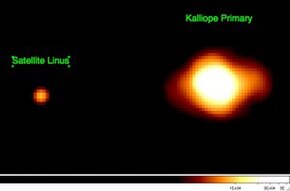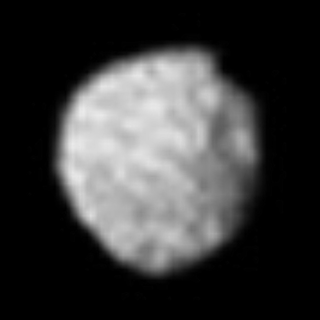
Puck is an inner moon of Uranus. It was discovered in December 1985 by the Voyager 2 spacecraft. The name Puck follows the convention of naming Uranus's moons after characters from Shakespeare. The orbit of Puck lies between the rings of Uranus and the first of Uranus's large moons, Miranda. Puck is approximately spherical in shape and has diameter of about 162 km. It has a dark, heavily cratered surface, which shows spectral signs of water ice.
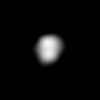
Belinda is an inner satellite of the planet Uranus. Belinda was discovered from the images taken by Voyager 2 on 13 January 1986 and was given the temporary designation S/1986 U 5. It is named after the heroine of Alexander Pope's The Rape of the Lock. It is also designated Uranus XIV.

A minor-planet moon is an astronomical object that orbits a minor planet as its natural satellite. As of January 2022, there are 457 minor planets known or suspected to have moons. Discoveries of minor-planet moons are important because the determination of their orbits provides estimates on the mass and density of the primary, allowing insights into their physical properties that are generally not otherwise accessible.
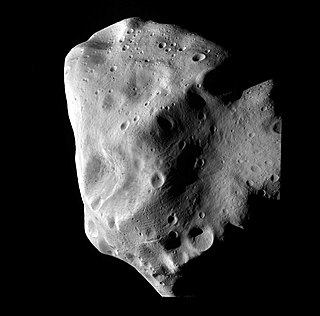
M-type asteroids are a spectral class of asteroids which appear to contain higher concentrations of metal phases than other asteroid classes, and are widely thought to be the source of iron meteorites.

Antiope is a double asteroid in the outer asteroid belt. It was discovered on October 1, 1866, by Robert Luther. In 2000, it was found to consist of two almost-equally-sized bodies orbiting each other. At average diameters of about 88 km and 84 km, both components are among the 500 largest asteroids. Antiope is a member of the Themis family of asteroids that share similar orbital elements.
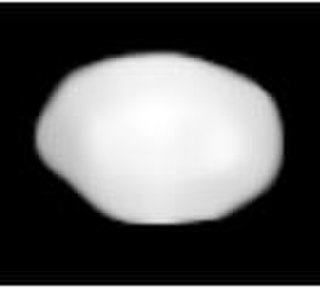
Eugenia is a large asteroid of the asteroid belt. It is famed as one of the first asteroids to be found to have a moon orbiting it. It was also the second triple asteroid to be discovered, after 87 Sylvia.
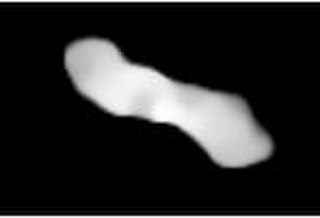
216 Kleopatra is a large M-type asteroid with a mean diameter of 120 kilometers and is noted for its elongate bone or dumbbell shape. It was discovered on 10 April 1880 by Austrian astronomer Johann Palisa at the Austrian Naval Pola Observatory, in what is now Pula, Croatia, and was named after Cleopatra, the famous Egyptian queen. It has two small minor-planet moons which were discovered in 2008 and later named Alexhelios and Cleoselene.

Ijiraq, or Saturn XXII (22), is a small prograde irregular satellite of Saturn. It was discovered by the team of Brett Gladman, John J. Kavelaars, et al. in 2000, and given the temporary designation S/2000 S 6. It was named in 2003 after the ijiraq, a creature in Inuit mythology.
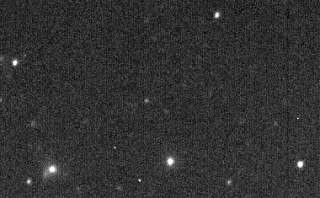
Erriapus, or Saturn XXVIII (28), is a prograde irregular satellite of Saturn. It was discovered by Brett Gladman, John J. Kavelaars and colleagues in 2000, and given the temporary designation S/2000 S 10. It was named Erriapo in August 2003 after Erriapus, a giant in Gaulish mythology; the name was changed from dative Erriapo to nominative Erriapus per IAU conventions in late 2007.
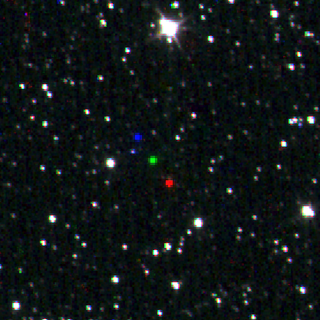
Siarnaq, also designated Saturn XXIX, is the second-largest irregular moon of Saturn. It was discovered on 23 September 2000 by a team of astronomers led by Brett J. Gladman. It was named after the Inuit goddess of the sea, Siarnaq, who is more commonly known as Sedna. Siarnaq is the largest member of Saturn's Inuit group of prograde irregular moons, which orbit far from Saturn in the same direction as the planet's rotation. The moons of the Inuit group are believed to have originated as fragments from the collisional breakup of a larger progenitor moon after it was gravitationally captured into orbit around Saturn several billion years ago. Several other small Inuit group moons share similar orbits to Siarnaq, indicating that the moon had experienced another collision after forming from its progenitor.

Camilla is one of the largest asteroids from the outermost edge of the asteroid belt, approximately 250 kilometers in diameter. It is a member of the Sylvia family and located within the Cybele group. It was discovered on 17 November 1868, by English astronomer Norman Pogson at Madras Observatory, India, and named after Camilla, Queen of the Volsci in Roman mythology. The X-type asteroid is a rare trinary asteroid with two minor-planet moons discovered in 2001 and 2016, respectively. It is elongated in shape and has a short rotation period of 4.8 hours.
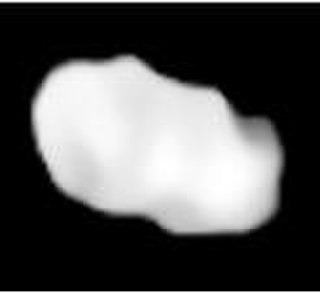
Elektra is a large outer main-belt asteroid and quadruple system with three minor-planet moons. It was discovered on 17 February 1873, by astronomer Christian Peters at Litchfield Observatory, New York, and named after Electra, an avenger in Greek mythology.
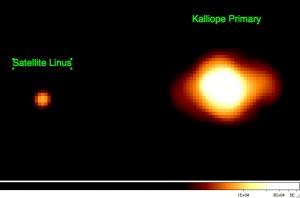
Kalliope is a large M-type asteroid from the asteroid belt discovered by J. R. Hind on 16 November 1852. It is named after Calliope, the Greek Muse of epic poetry. It is orbited by a small moon named Linus.

Huenna is a large asteroid orbiting in the asteroid belt. It is part of the Themis family, and thus a C-type asteroid and consequently composed mainly of carbonaceous material.
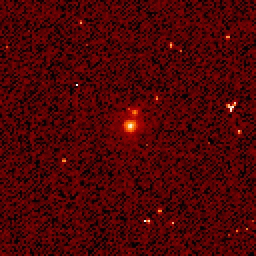
47171 Lempo, or as a binary (47171) Lempo–Hiisi (provisional designation 1999 TC36), is a trans-Neptunian object and trinary system from the Kuiper belt, located in the outermost regions of the Solar System. It was discovered on 1 October 1999, by American astronomers Eric Rubenstein and Louis-Gregory Strolger during an observing run at Kitt Peak National Observatory in Arizona, United States. Rubenstein was searching images taken by Strolger as part of their Nearby Galaxies Supernova Search project. It is classified as a plutino with a 2:3 mean-motion resonance with Neptune and is among the brighter TNOs. It reached perihelion in July 2015. This minor planet was named after Lempo from Finnish mythology.

702 Alauda, provisional designation 1910 KQ, is a carbonaceous asteroid and binary system from the outer asteroid belt, approximately 190 kilometers in diameter. It is the parent body of the Alauda family. Discovered in 1910 by German astronomer Joseph Helffrich at Heidelberg Observatory, it was named after the lark (alauda). Its small moon, named Pichi üñëm, was discovered in 2007.
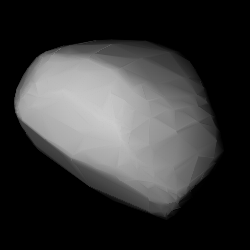
3749 Balam is a stony Flora asteroid and rare trinary system orbiting in the inner regions of asteroid belt. It also forms a secured asteroid pair with sub-kilometer sized asteroid (312497) 2009 BR60. Balam was discovered on 24 January 1982, by American astronomer Edward Bowell at Lowell's Anderson Mesa Station near Flagstaff, Arizona, and received the prov. designation 1982 BG1. It was named after Canadian astronomer David Balam. Balam measures approximately 4.1 kilometers (2.5 miles) in diameter. Its two minor-planet moons have an estimated diameter of 1.66 and 1.84 kilometers, respectively.
4674 Pauling, provisional designation 1989 JC, is a spheroidal binary Hungaria asteroid from the innermost regions of the asteroid belt, approximately 4.5 kilometers in diameter. It was discovered by American astronomer Eleanor Helin at the U.S. Palomar Observatory, California, on 2 May 1989, and named after the American chemist and Nobel laureate Linus Pauling.

Romulus is the outer and larger moon of the main-belt asteroid 87 Sylvia. It follows an almost-circular and close-to-equatorial orbit around the asteroid. In this respect it is similar to the other Sylvian moon Remus.
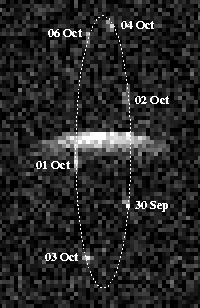
(185851) 2000 DP107 is a sub-kilometer sized asteroid, classified as potentially hazardous asteroid and near-Earth object of the Apollo group that is notable because it provided evidence for binary asteroids in the near-Earth population. The PROCYON probe developed by JAXA and the University of Tokyo was intended to flyby this asteroid before its ion thruster failed and could not be restarted.
